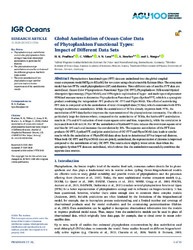Global Assimilation of Ocean-Color Data of Phytoplankton Functional Types: Impact of Different Data Sets
DOI: https://doi.org/10.1029/2019JC015586
Persistent URL: http://resolver.sub.uni-goettingen.de/purl?gldocs-11858/9145
Persistent URL: http://resolver.sub.uni-goettingen.de/purl?gldocs-11858/9145
Pradhan, H. K.; Völker, C.; Losa, S. N.; Bracher, A.; Nerger, L., 2020: Global Assimilation of Ocean-Color Data of Phytoplankton Functional Types: Impact of Different Data Sets. In: Journal of Geophysical Research: Oceans, Band 125, 2, DOI: 10.1029/2019JC015586.
 |
Dokument öffnen: |
Phytoplankton functional-type (PFT) data are assimilated into the global coupled ocean-ecosystem model MITgcm-REcoM2 for two years using a local ensemble Kalman filter. The ecosystem model has two PFTs: small phytoplankton (SP) and diatoms. Three different sets of satellite PFT data are assimilated: Ocean-Color-Phytoplankton Functional Type (OC-PFT), Phytoplankton Differential Optical Absorption Spectroscopy (PhytoDOAS), and SYNergistic exploitation of hyper- and multi-spectral precursor SENtinel measurements to determine Phytoplankton Functional Types (SynSenPFT), which is a synergistic product combining the independent PFT products OC-PFT and PhytoDOAS. The effect of assimilating PFT data is compared with the assimilation of total chlorophyll data (TChla), which constrains both PFTs through multivariate assimilation. While the assimilation of TChla already improves both PFTs, the assimilation of PFT data further improves the representation of the phytoplankton community. The effect is particularly large for diatoms where, compared to the assimilation of TChla, the SynSenPFT assimilation results in 57% and 67% reduction of root-mean-square error and bias, respectively, while the correlation is increased from 0.45 to 0.54. For SP the assimilation of SynSenPFT data reduces the root-mean-square error and bias by 14% each and increases the correlation by 30%. The separate assimilation of the PFT data products OC-PFT, SynSenPFT, and joint assimilation of OC-PFT and PhytoDOAS data leads to similar results while the assimilation of PhytoDOAS data alone leads to deteriorated SP but improved diatoms. When both OC-PFT and PhytoDOAS data are jointly assimilated, the representation of diatoms is improved compared to the assimilation of only OC-PFT. The results show slightly lower errors than when the synergistic SynSenPFT data are assimilated, which shows that the assimilation successfully combines the separate data sources.
Statistik:
ZugriffsstatistikSammlung:
- Geographie, Hydrologie [453]
Schlagworte:
PFTData assimilation
ecosystem model
satellite data
phytoplankton community
joint assimilation
This is an open access article under the terms of the Creative Commons Attribution License, which permits use, distribution and reproduction in any medium, provided the original work is properly cited.

